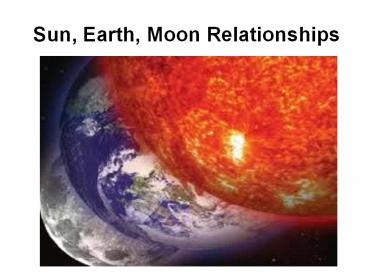Sun, Earth, Moon Relationships - PowerPoint PPT Presentation
1 / 45
Title:
Sun, Earth, Moon Relationships
Description:
Sun, Earth, Moon Relationships Penumbra lighter portion of the Earth s or moon s shadow. A person standing in the penumbra sees a partial eclipse. – PowerPoint PPT presentation
Number of Views:462
Avg rating:3.0/5.0
Title: Sun, Earth, Moon Relationships
1
Sun, Earth, Moon Relationships
2
1. As long ago as 350B.C. Aristotle knew that
the world was round.
Earth always cast a round shadow during an eclipse
3
2. An axis is an imaginary line around which an
object spins.
4
3. Rotation is the spinning of an object on its
axis.
5
(No Transcript)
6
5. Earth completes 365 ¼ rotations in 1 year.
4. Earth completes 1 period of rotation in about
24 hours.
7
6. A revolution is the orbiting of an object
around another.Earth completes 1 revolution in
365 days or 1 year.
8
7. The shape of Earths orbit is an ellipse.
9
8. Earth is closest to the sun on January 3rd at
147million km.
9. Earth is farthest from the sun on July 4th at
153 million km.
10
10. Earths axis is tilted 23½ from a line
perpendicular to its orbit.
11
(No Transcript)
12
(No Transcript)
13
11.1 The hemisphere tilted toward the sun
receives more radiation per unit area.
14
(No Transcript)
15
(No Transcript)
16
11.2 The hemisphere tilted toward the sun
receives more hours of daylight.
17
12.During the fall and spring equinox the sun is
directly over the equator.Spring equinox
March 21, 22Fall equinox September 22, 23
18
(No Transcript)
19
13.At the summer solstice the sun is over the
Tropic of Cancer. At the winter solstice the
sun is over the Tropic of Capricorn. Summer
solstice June 21, 22Winter solstice December
21,22
20
B
Spring
153 million km
147 million km
Summer
C
A
Winter
D
Fall
21
Fall
153 million km
Winter
Summer
147 million km
Spring
22
22.2 Earths Moon
23
(No Transcript)
24
1. It takes 27 1/3 days for the moon to rotate
once on its axis.
2. It takes 27 1/3 days for the moon to revolve
once around Earth.
25
3. We always see the same side of the moon
because it rotates and revolves at the same speed.
4. The moon shines by reflecting sunlight.
26
5. Waxing when the lighted portion of the
moon grows larger.
6. Waning when the lighted portion of the
moon becomes smaller.
27
7. It takes 29 ½ days for the moon to complete
its cycle of phases.
28
(No Transcript)
29
(No Transcript)
30
9. The revolution of the moon and Earth causes
eclipses.
10. There are 4/year. 2 solar and 2 lunar.
31
11. Solar eclipse when the moon blocks the sun
from the Earth.
32
12. Lunar eclipse when the Earth blocks the
sun from the moon.
33
- Umbra darkest portion of the Earths or moons
shadow. - A person standing in the umbra sees a total
eclipse.
34
- Penumbra lighter portion of the Earths or
moons shadow. - A person standing in the penumbra sees a partial
eclipse.
35
If you see a total lunar eclipse the moon is in
the Earths umbra. If you see a partial lunar
eclipse the moon is in the Earths penumbra.
36
(No Transcript)
37
(No Transcript)
38
15. Maria dark regions of solidified lava,
formed 3.2-3.8 billion years ago.
39
16. Copernicus and Tycho are craters caused by
the impact of a meteor or an asteroid.
40
Copernicus
41
Tycho
42
3 main theories of how the moon formed 1.
Accretion the moon condensed from loose
material surrounding Earth as it was forming.
43
2. Capture the moon formed elsewhere,
wandered into Earths vicinity and was captured
by Earths gravity
44
(No Transcript)
45
- Impact A Mars-sized object collided with
Earth as it was forming. The ejected debris
condensed and formed the moon. - The Impact Theory is the most widely accepted by
scientists today.

